|
[DECAPODS]
|
|
|
|
74a
|
(27)
&
(29) |
Abdomen reduced and folded under the carapace OR soft and degenerate (that is, not very crustacean-like). { Marine and estuarine. Crabs and hermit crabs
|
[90 ] ]
|
|
74b
|
|
Abdomen NOT reduced, about as long as or longer than cephalothorax and with a caudal fan. { Marine, estuarine, and freshwater. Shrimps and prawns
|
[75]
|
|
|
|
~~~~~~~~~~~~~~~~~~~~~~~~~~~~~
|
|
75a
|
(74) |
First three pairs of legs with small or large claws (chelae). Lateral margins of 2nd abdominal segment do NOT overlay margins of first abdominal segment
|
[76]
|
|
75b
|
|
First two pairs of legs with chelae, the remaining three pairs are simple. Lateral margins of 2nd abdominal segment over-lay margins of first abdominal segment
~ Section CARIDEA
|
[77]
|
|
|
|
~~~~~~~~~~~~~~~~~~~~~~~~~~~~~
|
|
76a
|
(75) |
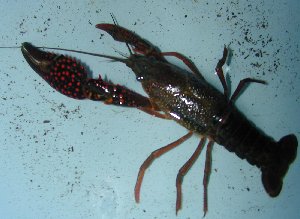 Strongest claw(s) on first pair of legs. Cephalothorax is sub-cylindrical and abdomen more or less flattened dorsoventrally (top to bottom). American swamp crayfish, crawdad.
Strongest claw(s) on first pair of legs. Cephalothorax is sub-cylindrical and abdomen more or less flattened dorsoventrally (top to bottom). American swamp crayfish, crawdad.~ Section ASTACIDEA ~ Family CAMBARIDAE Procambarus clarki Girard
|
|
|
76b
|
|
Strongest claw(s) on second pair of legs. Cephalothorax and abdomen both compressed laterally (side to side)
~ Section PENAEIDAE
|
[Note D]
|
|
|
|
~~~~~~~~~~~~~~~~~~~~~~~~~~~~~
|
|
77a
|
(75) |
One pair of claws clearly stronger than the other pair, and carpal segment cylindrical; claws lacking bushy tufts of fine hairs on fingers
~ Family PALAEMONIDAE
|
[78]
|
|
77b
|
|
Both pairs of claws more or less equal in size and the carpel segment V-shaped, opening distally (towards claw); fingers with dense tufts of brush-forming hairs
~ Family ATYIDAE
|
[85]
|
|
|
|
Key to Family Palaemonidae
|
|
78a
|
(77) |
Second pair of legs with strongest claws, the first pair of legs a shorter, thinner version of the 2nd pair
|
[79]
|
|
78b
|
|
First pair of legs bearing at least one strong claw, 2nd pair of legs longer, thinner, and with only very weak claws
Unidentified Species 'A"
|
|
|
|
|
~~~~~~~~~~~~~~~~~~~~~~~~~~~~~
|
|
79a
|
(78) |
Antennal and branchiostegal spines present on carapace
|
[80]
|
|
79b
|
|
Antennal and hepatic spines present, brachiostegal spine is absent
|
[82]
|
|
|
|
~~~~~~~~~~~~~~~~~~~~~~~~~~~~~
|
|
80a
|
(79) |
Mandible without a palp. Telson with three pairs of spines in addition to hairs
Palaemonetes spp.
|
[Note D]
|
|
80b
|
|
Mandible with palp. Telson with two pairs of spines plus hairs
|
[81]
|
|
|
|
~~~~~~~~~~~~~~~~~~~~~~~~~~~~~
|
|
81a
|
(80) |
 Rostrum narrow, and curved upwards, a little longer than antennal scale; rostral formula typically 5 over 6 (1 + 1-7/3-10), with a long gap between tip and next dorsal tooth. Very common in estuarine or brackish water. Grass shrimp. [IND]
Rostrum narrow, and curved upwards, a little longer than antennal scale; rostral formula typically 5 over 6 (1 + 1-7/3-10), with a long gap between tip and next dorsal tooth. Very common in estuarine or brackish water. Grass shrimp. [IND]
Palaemon debilis Dana
|
|
|
81b
|
|
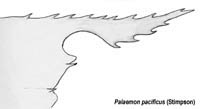 Rostrum only three to four eye-lengths long, about as long as antennal scale; rostral formula is 2-3 + 7-9 / 4-5. Narrow, dark bands marking sides of carapace and abdomen. [IND] Rostrum only three to four eye-lengths long, about as long as antennal scale; rostral formula is 2-3 + 7-9 / 4-5. Narrow, dark bands marking sides of carapace and abdomen. [IND]
Palaemon pacificus (Stimpson)
|
|
|
|
|
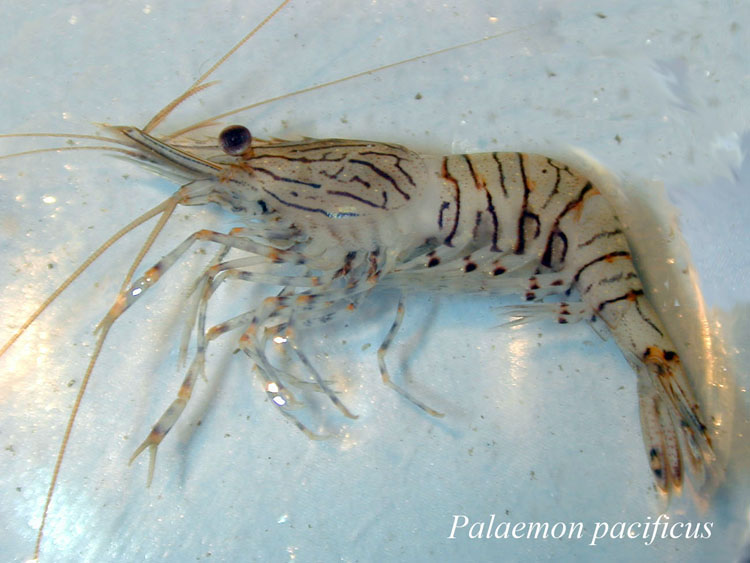
|
|
|
|
~~~~~~~~~~~~~~~~~~~~~~~~~~~~~
|
|
82a
|
(79) |
Supra-orbital spine present on carapace in addition to hepatic and branchiostegal spines. Rostral formula 1 + 6-8 / 2-4; rostrum curved upwards and extending a little beyond antennal scale. Estuarine, usually in mangroves
Periclemenes andamanensis Kemp
|
|
|
82b
|
|
Only antennal and hepatic spines present on carapace
|
[83]
|
|
|
|
~~~~~~~~~~~~~~~~~~~~~~~~~~~~~
|
|
83a
|
(82) |
Carpus distinctly longer than merus. Rostrum long and curved upwards, with a distinct basal crest; lower margin with 8 - 14 teeth. Tip of telson extends beyond the posterior spines. Aquaculture freshwater species; apparently not naturalized. Malaysian prawn
Macrobrachium rosenbergii
|
[Note A] |
|
83b
|
|
Carpus about the same length as or shorter than merus. Rostrum and telson not exactly as above
|
[84] |
|
|
|
~~~~~~~~~~~~~~~~~~~~~~~~~~~~~
|
|
84a
|
(83) |
Upper margin of rostrum with about 8 teeth; lower with 2. Larger adults with very long, equal or subequal, roughened, blue chelipeds (2nd legs). Freshwater streams. Pacific Islands prawn
Macrobrachium lar (Fabricius)
|
|
|
84b
|
|
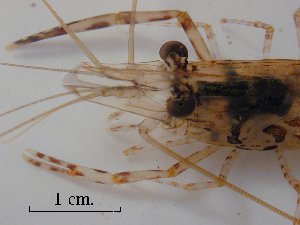 Upper margin of rostrum with about 13 to 17 teeth, lower margin with 4-5. Larger adult males with very unequal chelipeds, the larger with a distinct patch of hairs near the base of the palm. Lower reach of streams and estuaries. `opae `oeha`a. [END]
Upper margin of rostrum with about 13 to 17 teeth, lower margin with 4-5. Larger adult males with very unequal chelipeds, the larger with a distinct patch of hairs near the base of the palm. Lower reach of streams and estuaries. `opae `oeha`a. [END]Macrobrachium grandimanus Randall
|
|
|
|
|
Key to Family Atyidae
|
|
85a
|
(77) |
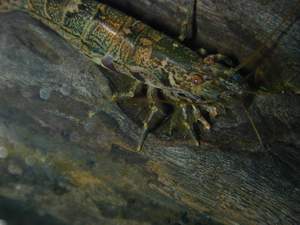 Rostrum short, reaching to base of middle segment of antennular peduncle (three joints supporting the antennules); usually lacking teeth (rostral formula 0 + 0 / 0-2). Claws (chelae) of both 1st and 2nd legs excavate, with little or no palm; carpal segments also short and excavate. Up to 5 cm long, in mountain streams. `opae kala`ole. [END]
Rostrum short, reaching to base of middle segment of antennular peduncle (three joints supporting the antennules); usually lacking teeth (rostral formula 0 + 0 / 0-2). Claws (chelae) of both 1st and 2nd legs excavate, with little or no palm; carpal segments also short and excavate. Up to 5 cm long, in mountain streams. `opae kala`ole. [END]
Atyoida bisulcata Randall
|
|
|
85b
|
|
Rostrum longer, reaching close to end of middle segment of antennular peduncle; armed with 13 (12-17) close-set teeth on dorsal surface and a close grouping of 2-4 teeth near middle of ventral surface. Chelae of 1st and 2nd legs with palms; carpus of 2nd leg NOT excavate, about as long as chela. To 2 cm. In streams, usually out feeding during the day. Taiwan blue shrimp
Neocaridina denticulata sinensis de Haan
|
[Note C] |